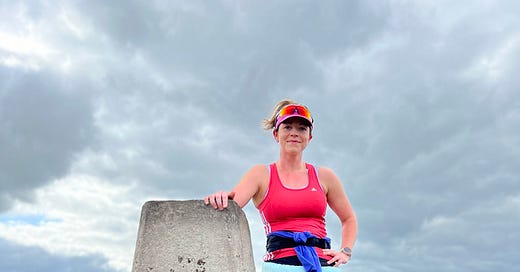On the theme of doing less, Out And Back is taking a break for a few weeks. We’ll be back as normal in April. Paid subscriptions have been paused.
Throughout my twenties, I refined my time and schedules so much that productivity and time efficiency are the unconscious themes of daily life. I did it so I could fit more things in.
I suspect my background in triathlon accelerated this behaviour. When faced with the dilemma of juggling three sports, a full-time job, a life, relationships, and somehow appearing good at it for long enough, it becomes a lifestyle, and you end up figuring out ways to maximise the 24 hours in a day.
I don’t remember a time when I wasn’t like this. I’ve always been curious about trying new things and continually learning about subjects that pique my interest. I never saw a limit to how many things one person could juggle at once, and only now am I starting to understand.
By mastering the art of productivity and being in the productivity trap, making every day and task efficient, I believed I could eventually (somehow) find a way to balance all these hobbies, interests, and sporting goals with normal life.
I learned the hard way that doing so is not good for your brain health when I started forgetting things, and I found some studies to understand why and some methods for doing things slightly differently.
I am working on trying to do less. But it has that vague description that, to me, brings associations to laziness. How do you do less? When people say they are doing “nothing”, I don’t know what that looks like.
What they mean is: watching TV, reading a book, having a bath, listening to music, having a cup of tea and looking at the birds, or engaging in recreational activities, all of which aren’t ‘nothing’, but are relaxing and perhaps less strenuous physically and mentally.
“I never saw a limit to how many things one person could juggle at once, and only now am I starting to understand.”
My brain is wired around the idea that doing more and working harder is the key to success; I am a ‘work until the job is done’ kind of person. A day off is not a day off, but a day to do other things I can’t fit in on a working day. A rest day is not a rest day, it’s just a day without exercise and a list of other things to get on with.
Although it does achieve ‘success’ in getting things ticked off and staying on track to the end goal, the real effects are burnout, stress, exhaustion and mental turmoil. So all I’ve really ‘achieved’ is misery and severe fatigue a few times a year. (I rebalanced this recently by adding relaxing or recreational activities to the schedule as a ‘task’ or ‘activity’ which makes them as important as getting the work done.)
When people ask me how I manage to balance so many things - as if I have secretly unlocked extra hours in the day - this is how I do it, and it’s how people like me do it, too. Maximising every minute of a day is not an efficient way of living, and it can be detrimental to brain health.
The first way of rectifying this is by doing less, committing to fewer things and thinking about productivity differently.
Task negative or downtime
You may have heard the term task-negative. It’s also closely associated with Default Mode Network, which means when doing some types of tasks, parts of your brain are deactivated. It is a “task-free environment” - in other words, not taking in or extracting information.
This deactivation mode is where the information gets processed and filed away in our brains.
Although being productive is generally a good thing – so much so that it’s used as an economic measurement – taking things to the extreme where your brain is constantly activated and taking in information means there’s no time to process it, so things become lost.
It’s like a library where new books are never processed and put on the shelf in the right place. They just sit there in a place that is supposed to be temporary, but they’re never processed, so information is not stored.
Reading a book is task-positive, or “attention demanding”. But things that require less concentration, like showering, washing dishes, meditating or daydreaming are task-negative.
So, ironically, carving out some time daily for daydreaming, meditation or sitting with a cup of tea and looking out of the window is more productive for our brains than shoehorning in another task.
What to do less of?
There are a lot of studies out there about why doing less is good for you, from scientific to well-being-based to anecdotal. It could also be about factoring in time to be spontaneous rather than having a rigid schedule every week.
The problem is, it can be hard to work out what to do less of. If all the things you do are priorities (work, family, friends, hobbies, health/exercise), one way of managing this is by rearranging them to maximise the cognitive benefits.
Until recently, I’ve divided my day into hourly blocks, so each one has an activity or task associated with it - for example, 7am-3pm: work; 3pm-5pm exercise; 5-7pm dinner, shower. But if work overruns, that sacrifices my exercise time and working late doesn’t necessarily mean more productivity.
This is where exercise breaks come in and is closely related to how exercise can be beneficial in problem-solving and improving thinking, from Ellie’s example a few weeks ago. To build upon that theory, scattering exercise throughout the day can be one way to meet all those priorities and maximise cognitive performance throughout.
Exercise breaks
In a study looking at how rest breaks can affect a mentally demanding task, exercise and relaxation breaks were superior to no break or an unstructured break (which in the study was staying at your desk).
The study concluded that “a 10–15‐minute brisk walk was found to reduce feelings of tiredness and increased feelings of energy in the short [immediate] and medium term [15 minutes after the break]”. While a relaxation break had a delayed effect of decreased fatigue and increased vigour, compared to no break and an unstructured break.
This means there is method in a lunch time training session, between meetings, or mentally demanding tasks (or a walk around the block).
Although it can be difficult to implement, as most people can’t just wander out of work when they want, I have tried this on revision and planning days or occasions where my working hours are more fluid and found it to be beneficial.
On the days where this approach is possible, by rearranging the blocks, I feel more focused, manage to hit all the priorities in the same amount of time and feel less mentally drained overall.
I’m learning to do less, how to think more practically about productivity and seeing it as a continuous practice. I can already see the benefit - it’s difficult, but I do love a challenge!
For more articles like this during the break, read them here.
Further listening:
Tim Harford & Dr. Laurie Santos have a great podcast episode on this from studies through history - why doing nothing could save you.
There is also a book on the subject - Subtract: The Untapped Science of Less by Leidy Klotz.
Recommendations
- - “‘Likes’ on social media is salt water to the creative condition, believe me”
- - “Every moment does not need to be productive, but it can always be purposeful”









It was a very interesting read. Self care and awareness is so important for our general health. Constantly trying to hit targets and fulfill tasks can be exhausting. Kick back, enjoy that tea or coffee, forget the self-imposed deadlines. Be more Becky 😄
Love this reflection! You might like the book The Power of Fun by Catherine Price. Along the same lines of your discussion, she discusses how play (along with rest) is instrumental in creating a healthy, fulfilling, joyful day (and life).